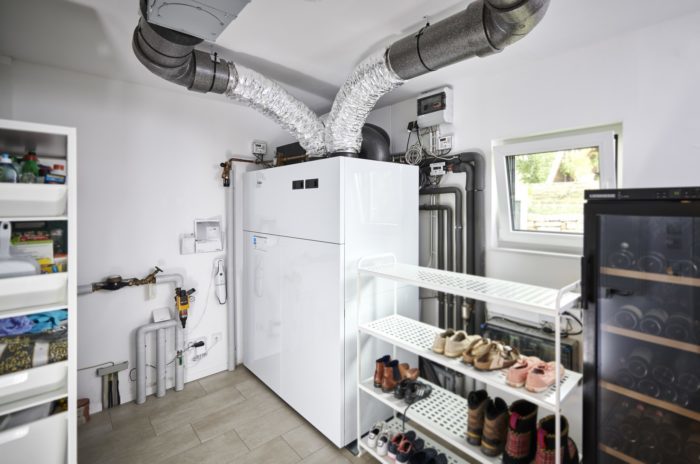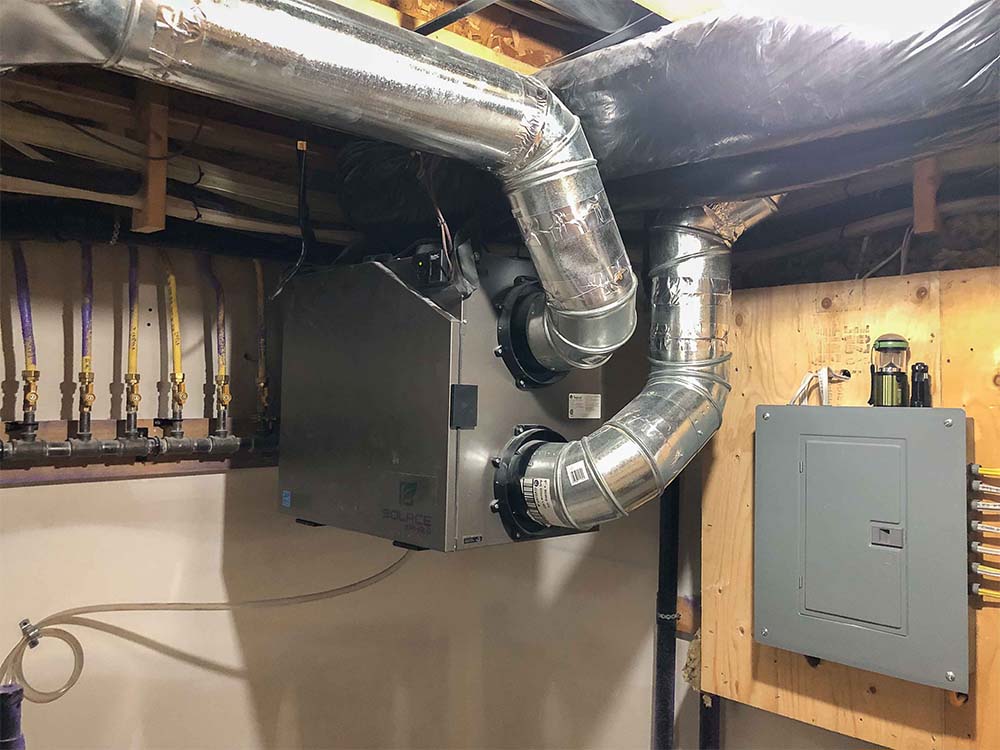Energy recovery heat exchanger is crucial in improving energy efficiency and indoor air quality. These innovative systems help to capture and reuse energy that would otherwise be wasted, making them an essential component of sustainable buildings. This blog post will explore the various aspects of energy recovery heat-exchangers, including their types, benefits, maintenance tips, and installation considerations.
Understanding Energy Recovery Heat-Exchangers
Energy recovery heat-exchangers are ingenious systems designed to transfer heat from one medium to another, optimising energy utilization within buildings. Predominantly, they serve to recuperate heat from exhausted air, utilising it to warm the incoming fresh air. This capability not only helps significantly reduce the heating demands of a building but also contributes to a marked decrease in cooling requirements during warmer months.
By doing so, energy recovery heat-exchangers are pivotal in slashing energy bills and diminishing the carbon footprint associated with heating and cooling operations. The operational mechanics of these systems are based on the principle of heat exchange, where heat is transferred without mixing the two fluids involved. Depending on the specific design and requirements of a building, these systems can be employed to either recover sensible heat, which involves a direct temperature exchange, or latent heat, which additionally captures moisture levels in the air, thereby aiding in humidity control.
This duality of function underscores their versatility and effectiveness in a broad spectrum of climatic conditions. Integral to the architecture of sustainable buildings, energy recovery heat-exchangers leverage advanced technology to harness waste energy, turning a potential loss into a valuable asset. Implementing such systems represents a forward-thinking approach to building design, prioritising not only environmental sustainability but also the health and Comfort of building occupants by ensuring a constant supply of fresh, tempered air.
The Significance of Installing a Home Air Heat Exchanger
A home air heat exchanger enhances indoor living environments by methodically exchanging stale indoor air with fresh external air. This dynamic process significantly mitigates the presence of indoor pollutants, including allergens, dust, and volatile organic compounds (VOCs), which can accumulate to harmful levels in tightly sealed homes. Additionally, by regulating moisture levels, these systems play a pivotal role in preventing the build-up of dampness and mound, conditions that are detrimental to the home’s fabric and its inhabitants’ health.
Implementing a home air-heat exchanger is particularly advantageous for individuals suffering from respiratory conditions or allergies, as it ensures a continuous supply of clean air, free from external pollutants and irritants. Moreover, this constant air exchange helps to neutralize odors from cooking, pets, and other domestic activities, creating a more pleasant and inviting home environment.
Installing a home air heat-exchanger beyond the immediate health benefits contributes to a home’s overall energy efficiency. By preconditioning the incoming air, these systems reduce the load on traditional heating and cooling systems, leading to lower energy consumption and, consequently, reduced utility bills. This efficiency elevates the Comfort of living spaces but aligns with broader environmental sustainability goals by lessening the household’s carbon footprint.
Exploring the Types of Heat Recovery Air Exchanger
Heat recovery air exchanger, pivotal in optimising a building’s energy efficiency, come in various types, each tailored to different needs and environmental conditions. The two primary categories are Rotary Heat Exchangers and Plate Heat Exchangers. Rotary Heat Exchangers, known as enthalpy wheels, excel in sensible and latent heat recovery. They utilise a rotating cylinder filled with a highly absorbent material to capture and transfer heat and moisture between the incoming and outgoing air streams.
This type is particularly effective in environments where maintaining indoor humidity is crucial. On the other hand, Plate Heat Exchangers operate by transferring heat between two adjacent flows of air through a series of plates. These systems are adept at sensible heat recovery, making them suitable for climates where humidity control is less of a concern, but heat recovery is still essential.
Within this category, there are further distinctions based on the configuration of the plates, such as cross-flow and counter-flow designs, each offering different efficiencies and capabilities. Each type of heat-recovery air exchanger has its specific advantages, making the choice largely dependent on the building’s location, design, and the particular requirements of its occupants.
Maintenance Tips for Your Energy Recovery Heat-Exchanger
Maintaining your energy recovery heat-exchanger in top condition is crucial for extending its lifespan and ensuring it operates at peak efficiency. Here are several practical steps to take:
Regularly Clean or Replace Air Filters
Dust and debris accumulation can impede airflow and diminish efficiency. Check the filters every few months and clean or replace them as necessary, depending on the system’s air quality and usage frequency.
Inspect the Heat-Exchanger Core
The core is the heart of your energy recovery heat-exchanger. A visual inspection for any signs of wear, damage, or blockage should be done at least once a year. Any accumulated dust or debris should be carefully removed according to the manufacturer’s instructions to prevent damage and maintain optimal performance.
Check for Leaks
Ensure all connections and ducts are sealed properly. Leaks can significantly reduce the system’s effectiveness and lead to energy wastage. Use appropriate sealing materials to fix any leaks.
Ensure Proper Ventilation
Adequate ventilation is essential for the heat exchanger to perform efficiently. Ensure that vents are not obstructed and that the system draws in and expels air as designed.
Professional Maintenance
While essential homeowners can perform basic maintenance, a professional should check the system annually. They can conduct a thorough inspection and carry out more complex maintenance tasks, ensuring your system continues to operate efficiently and effectively.
Advantages of a Fresh Air Heat Exchanger
The Fresh Air Heat Exchanger system offers a healthy and comfortable indoor environment and a green technology solution that addresses the rising concern of energy efficiency. Along with its economic benefits, its capability of humidity control and the flexibility of its use in various building designs make it an increasingly preferred choice for households.
Energy Efficiency
These systems precondition incoming air using the energy from the outgoing air, reducing the demand for heating and cooling systems and thus lowering energy consumption and utility bills.
Humidity Control
Fresh air heat-exchangers can help maintain optimal indoor humidity levels, reduce the likelihood of mound growth, and create a more comfortable living space.
Reduced Environmental Impact
By enhancing energy efficiency and reducing reliance on traditional heating and cooling systems, fresh air-heat exchangers contribute to a lower household carbon footprint.
Consistent Comfort
Exchanging air ensures that indoor temperatures remain stable and comfortable throughout the year, regardless of external weather conditions.
Long-Term Savings
The initial investment in a fresh air-heat exchanger is offset by the significant savings on energy bills over time, making it a cost-effective solution for improving indoor air quality and Comfort.
Flexibility in Use
Suitable for new builds and retrofits, these systems can be integrated into various architectural designs, ensuring they are accessible for a wide range of homes.
The Role of Heat-Recovery Air Exchangers in Sustainable Homes
In pursuing sustainable living, heat-recovery air exchangers emerge as indispensable allies. These systems embody the essence of energy conservation, capturing waste heat from exhaust air and using it to pre-condition incoming fresh air. This reduces the demand for heating and cooling systems and lowers a home’s overall energy consumption. In a world where environmental consciousness is paramount, integrating such technologies aligns perfectly with the ethos of green building practices.
Heat-recovery air exchangers contribute significantly to a home’s the Comfort without compromising air quality. By ensuring a steady exchange of air, they maintain an optimal balance between indoor air quality and energy efficiency, a critical factor in the design of eco-friendly homes. The ability to minimize energy loss while maximising comfort fees the kind of innovative solutions needed to address the challenges of modern, sustainable architecture.
These systems underscore the importance of holistic approaches in sustainable home design. By functioning as part of a greater ecosystem within the home, they exemplify how individual components can work together to achieve remarkable energy savings and reduce environmental impact. As sustainability becomes increasingly central to residential construction, the role of heat-recovery air exchangers in promoting energy-efficient, healthy living environments cannot be overstated.
Installing a Heat Exchanger Vent: What You Need to Know
When installing a heat exchanger vent, several key considerations must be taken into account to ensure optimal performance and energy efficiency. The selection of the vent’s location is paramount; it should facilitate easy access for maintenance and be situated in a manner that maximises energy recovery while minimising thermal loss. This often means avoiding areas prone to extreme temperature fluctuations.
Equally important is the configuration of the vent system to guarantee adequate ventilation. This includes assessing the capacity of the vent relative to the size of the space and the volume of air that needs to be exchanged. Proper airflow is critical to the efficient operation of a heat exchanger, as it maximises energy recovery, and the indoor air remains fresh and free of pollutants.
Commitment to a regular maintenance schedule is crucial for preserving the integrity and efficiency of the heat-exchanger vent. This involves routine checks for potential obstructions or debris that could impair airflow and reduce the system’s effectiveness. Attention to these details will facilitate the seamless integration of the heat-exchanger vent into your home, enhancing both the energy efficiency and the environmental comfort living space.
Conclusion
Energy recovery heat exchanger represents a transformative leap towards achieving greater energy efficiency and enhancing indoor air quality within our living and working environments. Their integration into modern building design underscores a commitment to environmental stewardship and marks a significant stride in pursuing healthier, more sustainable indoor climates. Through careful selection, routine maintenance, and proper installation, these systems offer a compelling solution to the dual challenges of energy conservation and air quality management.
FAQs
Q: How frequently should the air filters in my energy-recovery heat exchanger be cleaned or replaced?
A: The maintenance schedule for cleaning or replacing the air filters varies based on your indoor environment’s dust and debris levels. Typically, this should be done every three to six months to ensure optimal operation.
Q: Can install an energy recovery heat exchanger alone, or should I engage a professional?
A: Installing an energy recovery heat exchanger can be complex and requires understanding your home’s ventilation needs and the system’s requirements. While keen DIY enthusiasts might feel confident in undertaking this task, it is generally advisable to enlist the services of a professional. A professional installer can guarantee that the installation meets all necessary standards and functions efficiently, providing peace of mind and ensuring the system’s effectiveness and safety.
Q: Can heat-recovery air exchangers operate efficiently in all climate types?
A: Yes, heat-recovery air exchangers are designed to operate across a broad spectrum of climatic conditions. However, the choice of the system—whether focusing on sensible heat recovery, latent heat recovery, or both—should be tailored to your specific climate to ensure maximum efficiency and comfort home.
| Other Good Articles to Read |
| skank blogs |
| unreal blogs |
| tba blogs |
| all city forums |
| dany blogs |
| the music blogs |
| key forums |
| the big blog theory |
| joe blogs |
| blogs 4 me |
| Blogs Emon |
| Related Business Listings |
| Contact Directory |
| Local Business Profiles |



